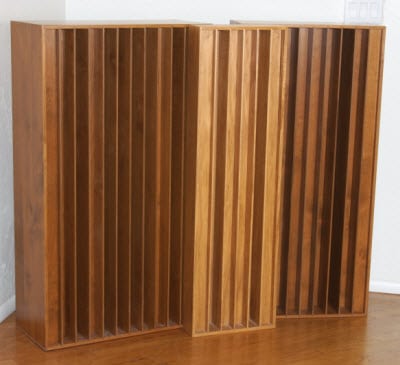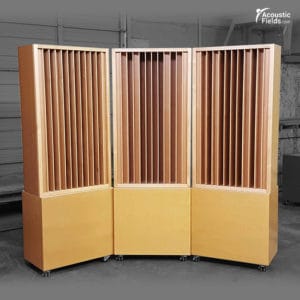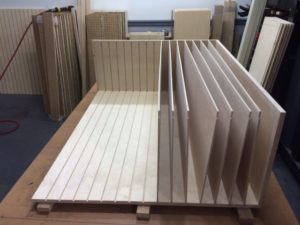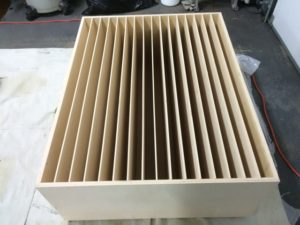With the changes in technology and materials available, this blog has been updated from its original posting to reflect new information in regards to what sound diffuser material I recommend. Updated on 11/12/19
What Sound Diffuser Material Do I Recommend?
Last week I was asked what sound diffuser material option I would recommend. Questions range from what the sound difference between wood and plastic would be and whether you could ever use cardboard or foam as a sound diffuser material. The use of foam as a sound diffuser is nothing more than manufacturing hype and misspeak in order to promote a product or technology that says sound absorption is sound diffusion. It is not.
If you’re not aware of the differences in those technologies and you purchased a “foam diffuser” product and got it installed in your room, you’ll realize that the terms are misused. It makes me sick to see that because companies take advantage of the ignorance of people and market these things and put names on them just because that’s what people search for. Do your own research and if you have any doubts pick up the phone and call me. I’ll always tell you what it’s supposed to be and I don’t really care what other manufacturers claim in order to sell a product.
Sound Takes On The Characteristic of The Surface it Strikes
It’s going to sound a little bit weird, but sound takes on the characteristics of the surfaces that it strikes. As a good example, sit in your car in your driveway and shut the engine off and leave your stereo on. Listen to that sound, that’s glass sound. Most of the surfaces in your car are glass so you’re going to get a really good idea of what glass sound is. If you have a tone control, turn the low frequency all the way down, maximize the treble and really listen to the reflections in your car. You won’t be able to stand it for too long nor should you.
Glass sound is an example of the sound quality you do not want. It’s the sound I hear immediately in a room even if you have only one window, I will hear it. It just jumps out at you when you understand what it really is like and hear it and understand it.Glass is an example of a surface that we do not want to use for anything that involves critical listening audio.
Foam Is a Sound Absorption Technology and Not a Sound Diffuser Material Option
Foam is a sound absorption technology, not a sound diffuser material and you would never make a diffuser out of foam. I don’t care what the literature says and I don’t care what other companies claim. Secondly, wood is a wonderful choice for a sound diffuser material. Why? You look at all the major studios and you look at all the rooms in the world that have a history of good recordings for voice and instruments, they have lots of wood.
Why? The natural materials on this planet produce the best sound. All the materials that the Earth produces or that we produce from the Earth make the best sound. Synthetics like plastics and glass are no good. Wood with its cost, ease of manufacturing, ease of build and selection, and there are so many great woods to choose from. Woods can be easily stained and sealed, they’re readily available in all parts of North America that I’m familiar with so it’s a good choice. Some other softwoods such as alder, pine, and birch work well and are economical.
The above shows a selection of the DIY sound diffuser kits we sell here.
What Wood Does Acoustic Fields Use?
We use a lot of cherry wood in our diffuser builds. Softer woods are good selections for a sound diffuser material because remember sound takes on the characteristics of the surface that it strikes. If sound strikes wood, you get a nice, smooth, warm, balanced tonal quality sound back into the room and that’s why I always tell people that a diffuser is a musical instrument.
If you really look at the instruments that we have at our disposal in terms of acoustical treatment, the diffuser is like a speaker because it has a sound quality of its own. It has a frequency response of its own, it has a place in the room it needs to be depending on the usage of the room. A diffuser has a lot of similarities to a speaker and I tell people that a diffuser is a musical instrument and you must use care in where it is placed within a room.
New Videos Coming Soon on Diffusion
We’re going to be doing a series of videos with my friend Bruce who added diffusion to his front wall. Now he’s adding diffusion to the rear wall. Now he wants diffusion on his ceiling. He is so enthralled and impressed because his life has changed acoustically with the power of diffusion which happens with most people when they hear it.
Most of our rooms have poor diffusion. Most of us out there, myself included up to 25 years ago, did not know the power of diffusion and I will tell you this, once you experience it, you will never go without it. Your acoustic life will be changed forever and you will never go back to just using just absorption. Low-frequency energy requires the use of absorption but for the middle and high frequencies diffusion is just an incredibly powerful tool and diffusion is one of the four major acoustical distortions we all have in our rooms.
Until you hear what it does and what it adds to the presentation, you’re really missing something and we’re trying to change that through these videos and through education. I’m almost getting to the point with all the designs we’ve been doing and customers I’ve been speaking with, and I never thought I would say this after 25 years, but I’m going to have to rank diffusion as almost equal in importance to low-frequency pressure management in terms of its impact on the sound quality within your room.
Bruce Has Listened to Music in Some of The Best Rooms in The World
Now Bruce is no spring chicken when it comes to listening in incredible sounding rooms given his son was the head of the Bolshoi Russian Ballet Company in Moscow. Bruce gets to travel around the world listening to some of the greatest rooms effectively and his feeling is that diffusion at home has been what’s he’s been missing his all life. He says that diffusion makes the room sound larger. It also adds clarity and definition to the presentation.
This is true for a lot of people, so disheartening because all these years people have been missing it. People understand absorption, most understand that you can’t have glass, you have to cover windows and doors most people get that. Most people understand that the listening position and the speakers have to have certain space requirements between them. Most people understand that the room size matters to the sound quality so I think we’ve done a fair job of educating people on these minimum requirements that you have to have to achieve some type of sound quality.
But now it’s time to start really dialing in what your electronics and gear are capable of because the missing link in the whole chain is your room and I always tell people, and our studio is a prime example, our gear in the studio was bought at a garage sale that cost less than $500, it sounds almost like 500,000 on certain days and that’s a large gap.
Electronics and Amplifies Have Come a Long Way
Our electronics and amplifiers have come so far that they’ve driven past the room acoustic treatment and we’re a little bit behind on all of that. The tools are good but we need to realize that it’s the room that’s really the largest element in this equation. When you treat a room for people that have not heard a correctly treated room, there’s just no substitute for the expression on their faces and the words that come out of their mouths. They also have had the awakening if you will and I guarantee you, everyone that we’ve had in our studio that’s experienced a room properly set up with diffusion hears this difference. Every person that we’ve had in that room has contacted me regarding adding diffusion to their rooms so that will tell you right away how powerful it is.
Our Goal With Diffusion
Diffusion is just incredibly powerful technology. Just like managing the low-frequency energy in your room and getting the bass to sound defined and separated, our goal with diffusion is to separate the middle and highs for greater definition. With a properly diffused room, you’d know that immediately when you walk into a room and you hit the play button. You know how the room handles the low end immediately, you can tell. This is the same thing is necessary with diffusion and can be achieved with diffusion. And then you get the two together, you’re going to get as close to hearing your music and being in a room but not hearing a room.
- Our Quadratic Diffuser with Base
- Quadratic Diffuser Interior Vertical Wells
- Quadratic Diffuser
You can see more of my research and development story and why I started Acoustic Fields at: https://www.acousticfields.com/who-we-are/.
Thanks,
Dennis












So for DIY diffusor is staining and sealing the wood recommended?
Hi Masis,
Staining and sealing is recommended.
this is incredible!!! would you have certain preferences that call for a skyline diffuser instead of this one, or is this the optimal diy design?
M, The word “Skyline” is a product name for a two dimensional diffuser. It was created By Peter D Antonio of RPG. Two dimensional diffusion and one dimensional diffusion each have their own distance requirements based upon room size/volume/usage. What application are you considering?
Hi,
What would you recommend for TV set placed between speakers, diffuser, absorber or some kind of combination?
Does anyone produce such “covers”?
Thanks in advance,
Nenad
N, If two channel listening, then diffusion.
Thanks on answer.
Yes, it is 2ch listening, it’s just that TV is in between.
Any diffuser solutions for TV sets?
N, Use one-dimensional diffusion across the front wall. You can build a door that has the diffusers in it and close the door when listening to music.
Thanks
Hi, Dennis.
What abouth marine plywood for QRD’s? I’m finding difficult to find any soft solid wood with 6mm lenght to buy here in Brasil. We just find with 10mm solid wood.
This marine plywood are made with pine leaves (Pinus elliottii) wood and phenolic glue pressed.
Can it work?
Best regards
L, Yes, marine ply will work.
Thanks. Now we talking!
Best regards from Brazil.
Hi Dennis,
I am building a recording studio and we are making our own doors. Do you have any suggestions on how I should make them?
D, What is the frequency and amplitude of the noise?
Does the amplitude of the sound affect overall how much absorbtion/diffusion one would need in any given room? If, for example, I play music at say 90dB, or I play music at say 70dB. I always play at low volumes (around 70dB). Would this lower sound level mean less requirements for absorbtion?
B, Yes, more amplitude more energy for the room to have to deal with. Lower amplitudes mean lower modal issue pressure but they are still audible.
Awesome videos Dennis! I was wondering, is there an overall percentage of a room that you would diffuse? I am working on a music room for kids and the teacher doesn’t believe they need much diffusion. It is about 40×30 and 18 in height.
P, Diffusion depends on room size/volume along with usage. There are no generalizations that can be universally applied.
Hi Dennis, great article! Interesting point about sound taking on the characteristic of the material it reflects from. I have a home studio with one wall that is floor to ceiling mirrors all the way down – would you count this as glass, and how would you recommend treating it?
Cheers- Jack
J, you are kidding me, right? No glass anywhere in a critical listening environment. This room needs work.
Hi Dennis, I want to make QRD diffuser from 1/4 plywood. Cedar or maybe cherry. Is it a good option? Not simple to find thin wood plank 25cm wide.
And, I try to find an answer to one question, but it’s difficult to find. How people calculate the height of QRD diffuser? I calculate the distance between dividers, and how deep must be each, but nobody knows anything about heigh for the vertically oriented diffuser.
I read some articles about the math of these diffusers, but usually, they say about the profile of it, not about heigh. Thank you ! De Sh
De, There is no one size fits all rooms. Cherry wood is best for middle-range tone. Do you have your low, middle, and high-frequency energy issues properly managed? If not, diffusers will make your room sound worse.
Yes, low and high are now good. This will be last piece for all setup. Thank you for help.
I am assuming that diffusion is the sound that is reflected by the surface of each well [i.e. horizontal fin] plus the resonance of the well cavity (like sound resonating inside of a soda bottle)
[in fact, I read that the ancient Romans put bottles in the walls of their amphitheatres to act as a type of diffuser or the Greeks used various architectural devices: https://www.livescience.com/7269-mystery-greek-amphitheater-amazing-sound-finally-solved.html%5D
QUESTION:
Do the upper, middle, and lower supporting blocks under the horizontal fins, which create the depth for each well, have to be made of the same material as the horizontal fins. Assuming the diffusion is from the well surface, the supporting blocks could be made of an inexpensive material (pine or popular) while the diffusing surface made of the more expensive optimum material (basswood, alder, or cherry)
Make the diffuser parts of the same wood.
You state that the optimum materials are softwoods such as basswood, alder, or cherry; cherry being “the best.”
One commercial vendor use “hardwoods: cherry, maple, oak and poplar” who states that they are acousticians and accredited by AIA (The American Institute of Architects) while other commercial vendors use baltic birch and while yet another major vendor “*** Acoustics’ sound diffusers use hardwood plywood that won’t shrink, swell or warp as much as lumber. We also use various materials for acoustic diffusion such as Thermally fused melamine paper applied to medium density fibreboard (MDF), EPS (expanded polystyrene), thin wood poly and high quality wood laminates to optimize the effectiveness of our acoustical diffusers. ”
I have “googled” endlessly to find information about the diffusing quality of wood species. At best, I found that some guitar bodies are made of basswood or alder.
QUESTION:
Can you recommend a source references which compare technically the diffusing quality of various woods.
We use cherry wood exclusively in our diffuser builds. It has the best tonal qualities of all woods.